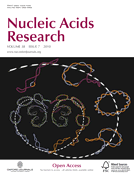
 NEW COVER published in print on April 12
NEW COVER published in print on April 12
Nucleic Acids Res. 2009 Dec 21. [Epub ahead of print]
DNA supercoiling and its role in DNA decatenation and unknotting.
Centre Intégratif de Génomique, Faculté de Biologie et de Médecine, Université de Lausanne and Laboratoire de Physique de la Matière Vivante, Faculté des Sciences de Base, Ecole Polytechnique Fédérale de Lausanne, 1015 Lausanne, Switzerland.
Chromosomal and plasmid DNA molecules in bacterial cells are maintained under torsional tension and are therefore supercoiled. With the exception of extreme thermophiles, supercoiling has a negative sign, which means that the torsional tension diminishes the DNA helicity and facilitates strand separation. In consequence, negative supercoiling aids such processes as DNA replication or transcription that require global- or local-strand separation. In extreme thermophiles, DNA is positively supercoiled which protects it from thermal denaturation. While the role of DNA supercoiling connected to the control of DNA stability, is thoroughly researched and subject of many reviews, a less known role of DNA supercoiling emerges and consists of aiding DNA topoisomerases in DNA decatenation and unknotting. Although DNA catenanes are natural intermediates in the process of DNA replication of circular DNA molecules, it is necessary that they become very efficiently decatenated, as otherwise the segregation of freshly replicated DNA molecules would be blocked. DNA knots arise as by-products of topoisomerase-mediated intramolecular passages that are needed to facilitate general DNA metabolism, including DNA replication, transcription or recombination. The formed knots are, however, very harmful for cells if not removed efficiently. Here, we overview the role of DNA supercoiling in DNA unknotting and decatenation.
